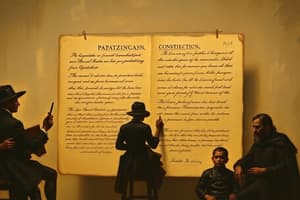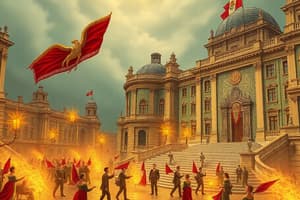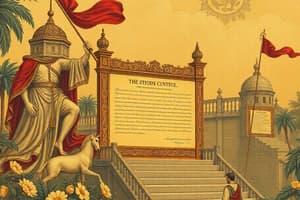Podcast
Questions and Answers
What was a primary goal of the Constitution of 1857?
What was a primary goal of the Constitution of 1857?
What major economic challenge did Mexico face in the years following the War of Independence?
What major economic challenge did Mexico face in the years following the War of Independence?
What characterizes the political climate during the Porfiriato?
What characterizes the political climate during the Porfiriato?
Which aspect was NOT addressed by the Constitution of 1917?
Which aspect was NOT addressed by the Constitution of 1917?
Signup and view all the answers
What was one effect of foreign investment during the Porfiriato?
What was one effect of foreign investment during the Porfiriato?
Signup and view all the answers
Which prominent figure was NOT a key leader during the Mexican Revolution?
Which prominent figure was NOT a key leader during the Mexican Revolution?
Signup and view all the answers
What was a significant outcome of the Mexican Revolution?
What was a significant outcome of the Mexican Revolution?
Signup and view all the answers
How did the Constitution of 1917 aim to foster national identity?
How did the Constitution of 1917 aim to foster national identity?
Signup and view all the answers
What key role did Miguel Hidalgo play in Mexican history?
What key role did Miguel Hidalgo play in Mexican history?
Signup and view all the answers
What significant change did the Constitution of 1824 introduce to Mexico's governance?
What significant change did the Constitution of 1824 introduce to Mexico's governance?
Signup and view all the answers
What was a primary consequence of the Mexican-American War?
What was a primary consequence of the Mexican-American War?
Signup and view all the answers
Which social group faced diminished power as a result of the Reform War?
Which social group faced diminished power as a result of the Reform War?
Signup and view all the answers
How did the internal conflicts in mid-19th century Mexico primarily affect governance?
How did the internal conflicts in mid-19th century Mexico primarily affect governance?
Signup and view all the answers
What impact did the rise of caudillos have on Mexican politics?
What impact did the rise of caudillos have on Mexican politics?
Signup and view all the answers
The conflicts between liberalism and conservatism in Mexico primarily resulted in which of the following?
The conflicts between liberalism and conservatism in Mexico primarily resulted in which of the following?
Signup and view all the answers
Which event directly followed the culmination of the Mexican War of Independence?
Which event directly followed the culmination of the Mexican War of Independence?
Signup and view all the answers
Flashcards
Constitution of 1857
Constitution of 1857
Established liberal reforms to limit Church power and secularize the state.
Economic Impact of the War of Independence
Economic Impact of the War of Independence
Led to economic hardships and loss of territory affecting Mexico's economy.
Foreign Influence on Mexican Economy
Foreign Influence on Mexican Economy
US and other foreign powers exploited resources, worsening Mexico's economic struggles.
Agrarian Issues
Agrarian Issues
Signup and view all the flashcards
Porfiriato
Porfiriato
Signup and view all the flashcards
Mexican Revolution (1910-1920)
Mexican Revolution (1910-1920)
Signup and view all the flashcards
Constitution of 1917
Constitution of 1917
Signup and view all the flashcards
National Unity in the Revolution
National Unity in the Revolution
Signup and view all the flashcards
Mexican War of Independence
Mexican War of Independence
Signup and view all the flashcards
Mexican-American War
Mexican-American War
Signup and view all the flashcards
The Reform War
The Reform War
Signup and view all the flashcards
Political instability
Political instability
Signup and view all the flashcards
Caudillos
Caudillos
Signup and view all the flashcards
Liberalism vs Conservatism
Liberalism vs Conservatism
Signup and view all the flashcards
French intervention in Mexico
French intervention in Mexico
Signup and view all the flashcards
Study Notes
Key Events and Processes
- The Mexican War of Independence (1810-1821) was a multifaceted conflict, leading to Mexico's separation from Spanish rule. Key figures like Miguel Hidalgo and José María Morelos were instrumental in igniting the independence movement.
- Following independence, Mexico's first government faced significant political instability and leadership changes. Defining a national identity, establishing governance, and securing borders were major challenges.
- The Constitution of 1824 established a federal republic, a stark contrast to Spanish colonial rule. However, implementing this constitution presented numerous obstacles.
- The Mexican-American War (1846-1848) resulted in substantial territorial losses for Mexico, encompassing large areas of the present-day American Southwest. Border disputes and conflicting claims fueled the conflict.
- The mid-19th century witnessed internal strife, including political instability, regional conflicts, and disputes over land ownership, alongside significant foreign intervention from the US and Europe.
- The Reform War (1857-1867) was a civil war in Mexico, driven by liberal reforms aimed at diminishing the power of the Catholic Church and military. These reforms were essential for Mexico's modernization efforts.
- French intervention in Mexico during the 1860s led to the establishment of a Second Mexican Empire under Maximilian of Habsburg. This replaced the existing republican government but ended with Maximilian's defeat.
Evolution of Political Systems
- Early Mexican governments struggled to balance federalist and centralist approaches, often adapting to internal political pressures and external threats.
- The 1824 federal republic provided a framework for government but experienced recurring conflicts and power struggles, hindering its effective application.
- Caudillos, influential regional leaders, significantly shaped Mexican politics. Their power often clashed with central authority, contributing to political instability.
- Liberal and conservative ideologies created deep societal divisions, impacting governance structures and frequently resulting in violence.
- The Constitution of 1857, a cornerstone of liberal reform, aimed to curtail Church power and secularize the state, reflecting evolving societal and political values.
Social and Economic Transformations
- The War of Independence, territorial losses, and internal conflicts severely impacted Mexico's economy in the early post-independence decades.
- Foreign powers, particularly the US, often exploited resources and imposed disadvantageous trade practices, hindering economic development.
- Agrarian issues, including land ownership and access, remained crucial concerns for Mexican society and government, especially surrounding the 1857 Constitution and the Reform War.
- Growing demand for Mexican resources and agricultural products increased the influence of foreign powers.
- Modernization and industrialization efforts faced numerous hindrances, including economic hardship and instability.
- Foreign investment played a significant role in Mexico's industry and infrastructure.
The Porfiriato (1876-1911)
- Porfirio Díaz's rule saw significant economic growth due to modernization, including infrastructure improvements, foreign investment, and industrial development in certain sectors.
- However, economic benefits were concentrated among a small elite, exacerbating inequality and social divides.
- Political authoritarianism and suppression of opposition characterized the Porfiriato, severely restricting individual rights.
- Indigenous populations and marginalized groups faced land dispossession and exploitation within the expanding economy.
- Underlying discontent ultimately fueled the Mexican Revolution.
The Mexican Revolution (1910-1920)
- The Mexican Revolution was a multi-faceted conflict addressing land reform, social justice, political reform, and wealth redistribution.
- Key figures like Francisco Madero, Emiliano Zapata, and Pancho Villa played crucial roles in the revolution.
- The revolution led to significant societal changes, including the introduction of the 1917 Constitution.
- The 1917 Constitution addressed land reform, labor rights, and restrictions on the Church and military, establishing a foundation for social justice. This constitution was a direct response to the turmoil of the revolution.
- The revolution fostered national unity amidst regionalism, creating a shared national identity in post-revolutionary Mexico.
- The revolutionary era was fraught with violence, societal upheaval, shifting alliances, and the quest for a new social and political order.
- The revolution contributed to the establishment of a more clearly defined national identity in Mexico.
Studying That Suits You
Use AI to generate personalized quizzes and flashcards to suit your learning preferences.
Description
Test your knowledge on key events and figures of the Mexican War of Independence and the subsequent establishment of the republic. Explore the challenges of governance and territorial disputes following independence. Learn about the impact of the Constitution of 1824 and the Mexican-American War.




